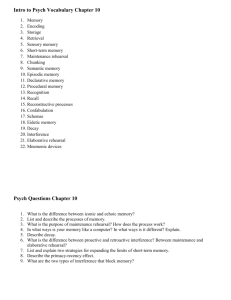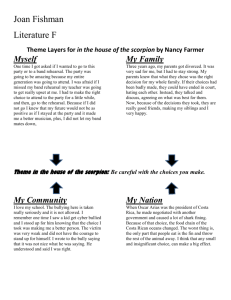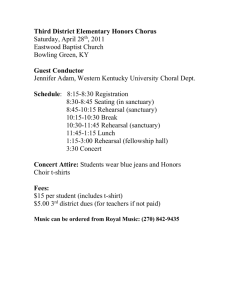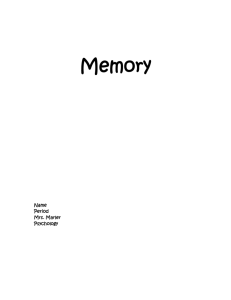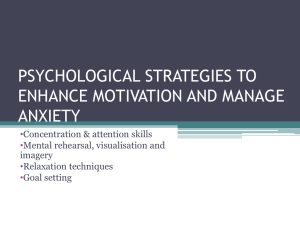Chapter 8 Powerpoint Slides
advertisement
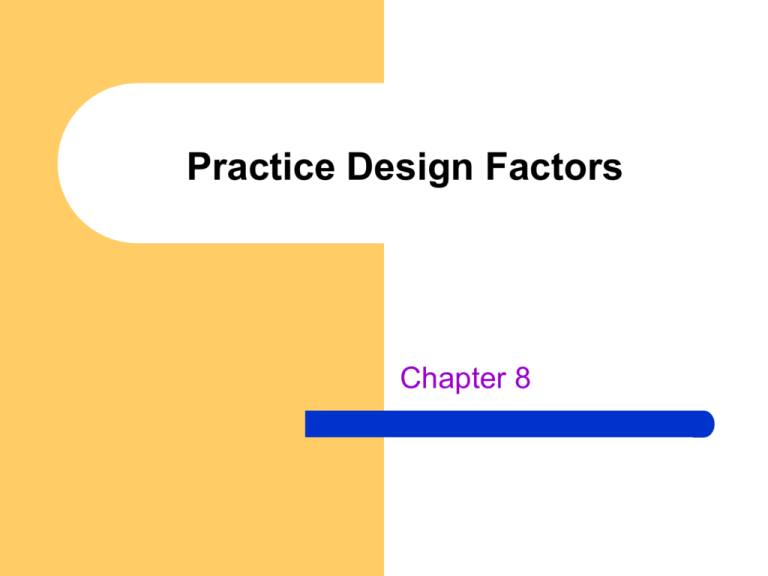
Practice Design Factors Chapter 8 INTRODUCTION What is better practice—the skill in parts or in its entirety? – – – Should one teach and practice the tennis serve in parts? Or in entirety? Should the patient be taught how to get out of bed in parts? Or in entirety? Should the student trainer be taught a shin splint taping procedure in parts? Or in entirety? Ask the following questions: – – – Would practicing a simplified version of the target skill transfer positively to performance of the whole skill? Would the learner’s time be more effectively spent practicing the whole skill? How much (if any) practice time should be devoted to part practice? Whole vs. Part Practice Nature of the skill – Task organization – Degree to which sub-components of the skill are interdependent and can or cannot be separated Task complexity Number of sub-components Information processing demands Whole vs. Part Practice Nature of skill (Task Organization) – Part practice works best for tasks where the actions involved in one part do not impact the actions involved in the next part E.g. passing a baton in a relay is independent of the running phase of the race Whole vs. Part Practice Nature of Skill (Task Complexity) – Use part practice when tasks are high in complexity, low in organization (can be separated) – Front crawl, transfer from bed to standing Use whole practice when tasks are low in complexity, high in organization (can’t easily be separated) Throwing a ball; transporting self in wheelchair Whole vs. Part Practice Task Complexity (Information processing) – Breaking the skill into component parts can reduce the amount of information processing Reduces the attentional demands Reduces the stimulus ID, response selection, response programming = reduced RT Prevents frustrating and overwhelming the learner Enhances more successful performance during the early learning stages (cognitive/early associative) Whole vs. Part Practice Capability of the Learner – – Part practice when: Learners have limited movement experiences Learners are overwhelmed by the task Cognitive or attentional requirements of task exceed learner’s capacity Whole practice when: Learners are highly motivated and have had a variety of movement experiences Part Practice: Segmentation Separates skill into parts according to spatial or temporal elements and practice is separated until the segment is learned – Part-whole method: A to proficiency - B to proficiency - AB – Progressive part method: A - B - AB - AB + C – Repetitive part method: A - AB- ABC – Forward chaining: A + B + C = ABC – Backward chaining: C + B + A = ABC Part Practice: Fractionization Skill components normally performed simultaneously are partitioned and practiced independently Complex skill of two or more parts Fractionization approach Related to bimanual skills in which one practices each arm separately before performing with the arms together – – – Playing an instrument Sidestroke in swimming Tennis serve Practice should begin with the hand that has the more difficult task Part Practice: Simplification Reduces level of difficulty of the task or some aspect of the task for the learner – Modify equipment; use assistive devices – Reduce the coordination requirements of the task – Simple to complex progressions – Reduce complexity of environment – Lead-up games – Provide a rhythmic pattern Whole vs. Part Practice : Attention Cueing Learner attention is directed towards a specific aspect of the skill during its performance as a whole Allows learner to concentrate on one particular task component or movement problem without disrupting the underlying temporal and spatial characteristics inherent to the skill Breaking down Skills: Speed-Accuracy Tradeoff A tradeoff exists between speed and accuracy An emphasis on speed negatively impacts accuracy and vice versa Breaking down Skills: Speed-Accuracy Tradeoff Implications for movement practitioners: – Emphasis on accuracy in initial stages of learning may impede the acquisition of efficient movement – A focus on accuracy in initial stages gives evidence to an incorrect movement But, focus on speed facilitated efficient movements In initial stages of learning, de-emphasize accuracy tasks and focus on real-time movement speed Focus on the process of the skill, rather than a product Bilateral Transfer When practice with one limb enhances the rate of skill acquisition with the opposite limb on the same task Greater degree of transfer occurs from the preferred to the non-preferred limb – Transfer seems to be asymmetric Skill should first be practiced with the dominant limb Once proficient, introduce to the non-preferred limb Theoretical Explanations Cognitive Motor control Cognitive Explanation Identical elements of the task performed by both limbs – – Learner knows ‘what to do’ Cognitive components which take up a learner’s attention have been learned before practice with opposite limb occurs Begin at a higher level of proficiency Motor Control Explanation The GMP is an abstract representation responsible for control of a class of actions – Muscles to do a task are parameters added to the program to achieve a goal of the action – The GMP specifies time and space features of a movement which can be adapted for a muscle group that has not practiced a movement The GMP develops for a skill as a result of practice Practice with one limb should transfer with a reasonable level of performance to another limb Mental Rehearsal Techniques Involves the visualization or cognitive rehearsal of a movement in the absence of any physical execution – Used as a preparatory strategy to enhance performance – Can reduce or control pre-competition anxiety – Increases self-confidence – Enhances motivation Mental Rehearsal Techniques Can mental rehearsal contribute to skill learning? – – Physical rehearsal is superior to mental rehearsal when a skill is learned Mental rehearsal is superior to NO rehearsal Effective for patients whose physical activity is restricted or for those whose injury prevents physical rehearsal – Consider how mental rehearsal could be used in therapy settings Types of Mental Rehearsal Mental Practice – Procedure through which learners think through the cognitive or procedural aspects of a motor skill in absence of overt movement – Strategies Cues General instructional information ‘how to’s’ presented Mental practice requires no equipment and can be done individually in a large group Types of Mental Rehearsal Mental Imagery – Procedure in which people imagine themselves performing a motor skill from either a first person or a third person perspective Internal perspective: they experience the movement and environment in which the skill is performed External perspective: experience the skill through a videotape replay of their performance Internal vs. External Which is best? – – When a closed skill that relies on form is to be practiced, external mental imagery may be better When a skill that connects the action to a product or desired outcome is to be practiced, internal mental imagery may be better Effective imagery stimulates both the look and feel of the actual movement Imagery Guidelines Practice Distraction free setting Start with familiar situations and skills Generate positive, vivid and controllable images Incorporate all senses Review: match the terms Fractionization Mental imagery Segmentation Simplification Mental practice Slow motion practice Gradual addition of parts of a complex skill Helps learners remember the procedural aspects of a skill The practice of a single part of a complex skill A springboard diver attempting to see and feel the dive before performing it Review Discuss the concept of part practice, and then describe how an instructor might use this type of practice in assisting a person who is learning to drive a stick-shift car Explain the differences between mental practice and mental imagery. Give an example of how a person who is learning to ballroom dance might use each type of mental rehearsal

